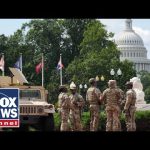In the bustling metropolis of Washington, D.C., a storm brews, and it’s not the meteorological kind. The city is plagued by a crime wave that seems to have no end in sight, leaving its residents jittery and apprehensive. From carjackings to gangs, Washington is a city where crime seems to be the unwelcome guest that refuses to leave. But fear not, as it seems like President Trump has taken it upon himself to save the city by deploying the National Guard to restore peace. However, not everyone is singing praises for this move.
The National Guard’s presence in the capital is reminiscent of a movie. With crime being a common occurrence, deploying troops to secure the streets might appear on paper as a logical step. After all, who wouldn’t want a little extra manpower when the streets feel like the set of an action thriller? Unfortunately, it’s not simply a tale of good versus evil. Some critics argue that this choice is a classic Trump maneuver—grandiose yet oversimplified. Sending in the troops just for some good photo ops might not earn Trump the Oscar for Best Director in this ongoing drama of urban living.
Media reactions have been predictably split. Predictable in the sense that any action by the former president generates a tidal wave of critique from certain segments of the media. They seem to trivialize the fearful experiences of many city dwellers by tossing around pie charts and statistics that claim crime levels are not as horrendous as they seem. One is left to wonder if these charts are supposed to comfort victims as they experience real-time crime on their doorsteps. But as it often goes with statistics, the reality faced by individuals does not always align with what’s plotted on a graph.
People living in the heart of D.C. or places like Ward 8 would beg to differ with all those neat little numbers. Their everyday experiences paint a different picture, one filled with trepidation about venturing out for a simple stroll or a trip to the store. Residents might scratch their heads at how statistics often fail to capture their individual stories. While some narratives speak of overall crime decreases, perhaps these residents are part of the 100% in their neighborhood who have experienced crime firsthand.
It’s not just in Washington where one can observe this tug-of-war. Many cities with largely Democratic leadership and significant minority populations face similar challenges, starkly highlighting the need for strategies beyond just law enforcement. It’s a complex issue that doesn’t yield to easy solutions such as just beefing up police presence or deploying troops.
Ultimately, this situation spotlights a fundamental rift. How do we address the complex interplay of crime, governance, and community needs in our cities? It’s a struggle that won’t end with a swift action or headline grab, but through consistent, carefully considered strategies that address root causes. In the meantime, the residents of D.C. continue to hope for safety while the media circus and political dance play on around them.




